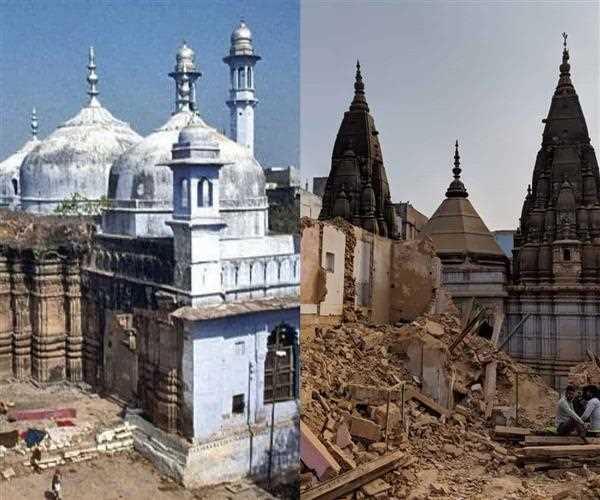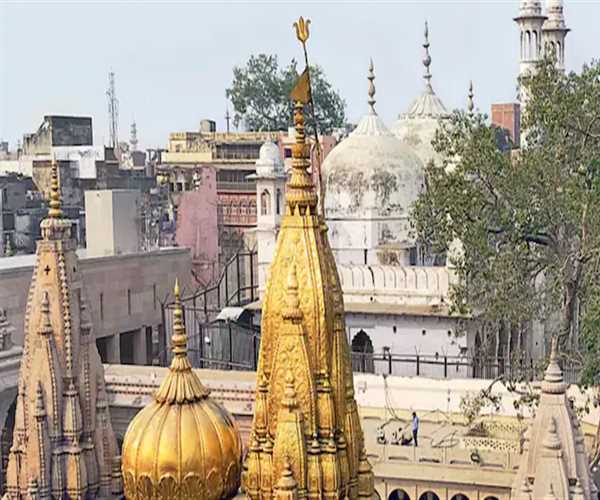Search here

04-Aug-2023 , Updated on 8/4/2023 5:49:40 AM
Explore the controversy between gyanvapi mosque or temple
Highlights
- Construction of Mosque- In the 17th century, Mughal Emperor Aurangzeb is said to have ordered the destruction of the original temple and the construction of Gyanvapi Mosque in its place.
- Religious Significance- The site holds immense religious importance for both Hindus and Muslims, leading to disputes and legal battles.
- Legal Controversy- Disputes regarding ownership and control of the site have been ongoing for decades, with legal cases in various courts.
- Architectural Features- The mosque exhibits Mughal architectural style, with intricate designs and carvings.
- Partial Remnants- Some believe that remnants of the original temple can still be seen within the mosque complex.
- Protected Monument- The site is a protected monument under the Archaeological Survey of India (ASI)
- Religious Harmony and Tensions- The Gyanvapi Mosque-Temple issue has been a point of tension between Hindu and Muslim communities, but it has also seen efforts towards interfaith understanding and reconciliation.
- Tourist Attraction- Despite controversies, the site attracts tourists and devotees due to its historical significance and its location in Varanasi.
The Gyanvapi Mosque-Temple controversy , centered around the Gyanvapi Mosque in Varanasi, India, is a complex and emotionally charged issue that highlights the delicate balance between historical preservation, religious sentiment, and cultural identity. The dispute revolves around claims that the mosque was built on the site of a pre-existing Hindu temple, sparking debates and legal battles that encapsulate the broader struggles between differing historical narratives and communal tensions. This essay seeks to explore the multiple facets of the Gyanvapi controversy, shedding light on its historical context, legal dimensions, religious sensitivities, and the implications it holds for India's secular fabric.
Historical Context
The Gyanvapi Mosque, also known as the Alamgir Mosque, was constructed in the 17th century during the reign of Mughal Emperor Aurangzeb. The mosque's location in Varanasi, a city renowned for its spiritual significance and cultural heritage, has made it a focal point of the dispute. Proponents of the temple theory argue that the mosque was erected after demolishing a revered Hindu temple dedicated to Lord Shiva. This narrative draws upon historical accounts and archaeological evidence that suggest the presence of Hindu architectural elements within the mosque's structure.

Legal Dimensions
The legal battle surrounding the Gyanvapi Mosque-Temple controversy has traversed various courts over the years. The most notable case was filed in 1991, seeking the restoration of the alleged temple's sanctity. The Allahabad High Court dismissed the petition, stating that the claim was time-barred, as the dispute arose centuries after the construction of the mosque. The verdict also emphasized the importance of maintaining communal harmony and preserving India's secular fabric.
In 2019, a fresh petition was filed in the Varanasi district court, reigniting the legal battle. As of the knowledge cutoff date in September 2021, the case was still pending, underscoring the complexity and sensitivity of the issue.
Religious Sensitivities
The Gyanvapi controversy is deeply intertwined with religious sensitivities and sentiments. For Hindus, Varanasi holds immense spiritual significance, and any suggestion that a Hindu temple was replaced by a mosque can evoke strong emotions. On the other hand, Muslims hold the mosque in reverence as a place of worship and historical significance. The interplay of these sentiments highlights the need for a nuanced approach that respects both faiths and seeks to bridge the gap between divergent narratives.
Secularism and National Identity
The Gyanvapi Mosque-Temple dispute resonates beyond its immediate context, reflecting broader issues related to secularism and national identity in India. India's constitution enshrines the principle of secularism, aiming to uphold religious pluralism and ensure equal treatment of all religions. However, in practice, maintaining this delicate balance often proves challenging, as seen in the Gyanvapi controversy . The dispute tests the nation's ability to reconcile historical grievances with its commitment to secular ideals.
Gyanvapi's guardian panel, the Anjuman Intizamiya Masjid (Point), says it likes to keep its confidence in the 1991 Spots of Love (Extraordinary Arrangements) Act than respond to subtle provocations. The Act, which was enacted by the Narasimha Rao government during the height of the Ram Janmabhoomi movement in 1991, stipulates that the religious character of all places of worship—with the exception of Ayodhya, which was the subject of litigation at the time—must be maintained in the same manner as it was on August 15, 1947.
In November 2019, when a five-judge seat of the High Court concluded the Ayodhya title suit for allowing the development of a sanctuary on the contested site, it maintained the arrangements of the 1991 Demonstration, expressing that, "In saving the personality of spots of public love, Parliament has commanded clearly that set of experiences and its wrongs will not be utilized as instruments to mistreat the present and what's in store."
Controversy for shivling vs fountain
Following the petition, a Varanasi court issued an April order for a video survey of the Gyanvapi mosque complex. The report of the overview was at first arranged to be presented by May 10. However, after Uttar Pradesh challenged the order, there was a delay. The survey report was originally supposed to be submitted by May 10. However, the order was challenged by the mosque committee and the Uttar Pradesh Sunni Central Waqf Board, which resulted in a delay. The Gyanvapi mosque review was finished up on May 16.
The Hindu side regarding this situation has guaranteed that a 'Shivling' was tracked down inside a repository on the mosque complex during the review. The Muslim side, nonetheless, excused the case and said it was just a 'wellspring'.

The Kashi Vishwanath Sanctuary Gyanvapi Mosque debate was raised by the BJP, the Vishva Hindu Parishad (VHP) and the RSS during the mission for the development of Slam Mandir in Ayodhya alongside the Krishna Janmabhoomi-Shahi Idgah Masjid in Mathura
The discussion has accepted a normal turn as both sides -Hindus and Muslims- have solidified their stand.
Implications and the Way Forward(My viewpoint)
The Gyanvapi Mosque-Temple controversy carries implications that extend far beyond its historical and religious dimensions. It has the potential to impact communal relations, cultural heritage preservation, and India's image on the global stage. A sensitive and well-informed resolution is essential to ensure that the nation's rich history and diverse heritage are preserved while safeguarding the rights and sentiments of all communities involved.A possible way forward could involve a collaborative approach, bringing together historians, archaeologists, religious scholars, and community representatives to conduct an impartial and comprehensive study of the site's history. This approach could yield insights that help dispel myths and shed light on the true origins of the Gyanvapi Mosque and the surrounding area. Such an initiative would require the active involvement of all stakeholders and a commitment to transparency, integrity, and open dialogue.
SEO and Content Writer
I am Drishan vig. I used to write blogs, articles, and stories in a way that entices the audience. I assure you that consistency, style, and tone must be met while writing the content. Working with the clients like bfc, varthana, ITC hotels, indusind, mumpa, mollydolly etc. has made me realized that writing content is not enough but doing seo is the first thing for it.
Join Our Newsletter
Subscribe to our newsletter to receive emails about new views posts, releases and updates.
Copyright 2010 - 2025 MindStick Software Pvt. Ltd. All Rights Reserved Privacy Policy | Terms & Conditions | Cookie Policy